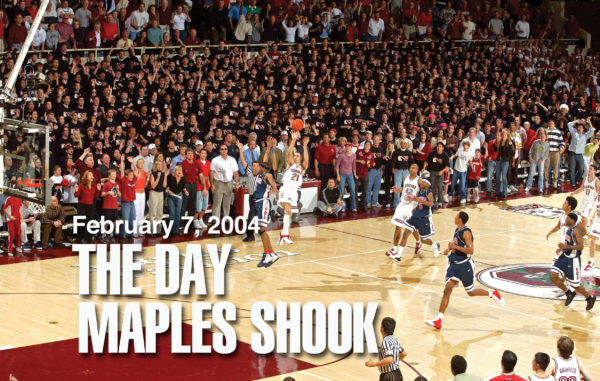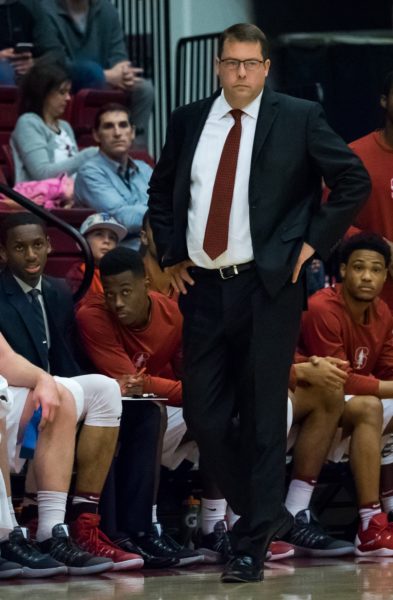Stanford Basketball Yearning For Its Glory Days (Or Is It?)…
Posted by Adam Butler on December 3rd, 2016You look around Maples Pavilion and you see empty rows of seats. If you look hard enough, I’m sure you could even find columns of seats right up to the not-all-that-high Maples ceiling. There’s empty booster level seating and you can hear conversations, noises perhaps unfamiliar to a more traditional college basketball environment. Just Wednesday night, following a loss inside Indiana’s Assembly Hall, North Carolina head coach Roy Williams lamented, “I’d like to play in front of a crowd like that in the Smith Center every night other than the frickin’ Duke game.” Indeed, what sets college basketball apart – and I suppose all college sports for that matter – is its atmosphere (not the frickin’ Duke game). The skill of professionals cannot be matched. Their stars are brighter and shots more true. Their arenas, however? Bigger but not always better. Or at least not louder. It is not the same. Stanford athletics, however, are a little different. It is not always an event. Sure there are scheduled contests with officials and media, hype men and even knockout at halftime. The requisite production remains. But it’s not destination sport. Their top-tier football program does not demand overflow attendance. And while the basketball program was once there and the floors would shake, they’ve also only been to one NCAA Tournament in the past eight seasons. It’s amazing what an NCAA Tournament appearance can do to an arena.
Following in the steps of a Hall of Famer is never easy. Trent Johnson escaped the shadow by progressively chasing lesser jobs (Stanford > LSU > TCU), while Johnny Dawkins sternly and rarely budged off of 18-wins. In either case, one of two critical components used in standard assessments of a program were missing: winning or charm. While the former speaks for itself and often excuses or masks a lack of the latter, wins are hard to come by. On charm, and particularly early in a coaching tenure, this can be used to excuse winning, a smile and a pep rally to lament the outgoing regime’s recruiting. Consider Ernie Kent walking door-to-door in Pullman or anything Bruce Pearl ever does. In either case (winning or charming), a coach and program are trying to set itself up for success on the recruiting trail and in the pocketbook. The recipe being some nonlinear combination of good players + wins + excitement + attendance. That’s how we generally evaluate a program.
But as previously noted, Stanford is different. New coach Jerod Haase hasn’t been as outwardly promotional as the aforementioned Kent or Pearl. Perhaps that’s not at all his style but it also doesn’t feel like a Cardinal necessity. You see in Palo Alto there seems to be a focus on fit. Interview in the Bay Area for a role and the hiring team will explore how you’d mesh with its culture. Consider this from the Stanford Graduate School of Business website: “We consider each application holistically, and take into account factors such as your background, experiences, perspectives, fit with Stanford GSB and its MBA Program, aspirations, values, and accomplishments.” Because unlike other programs, there’s a very specific player that Stanford attains. Players do not transfer from this school and they don’t leave for the NBA after a single year. Let’s call it destination basketball. The Stanford athlete is born and perhaps not selected. It’s not always clear who recruits whom, which subsequently means the leader of these teams must know how to navigate these constructs. He must be a cultural fit.
It was therefore interesting to see Haase in action last Wednesday night against Saint Mary’s and Randy Bennett. The Gaels’ coach is a tremendous example of fit. He’s come to understand the strengths and weaknesses of his program, the talent at his discretion optimized to be successful in a unfair playing field. He was the coach Stanford might have considered as their top option last spring. Cardinal brass, however, pulled Haase out of Birmingham. He’s a Bay Area (Tahoe) local who cut his coaching teeth under Roy Williams (speaking of charm). He won – unlike his immediate Stanford predecessor – increasingly more games in each of his four seasons at UAB. Interestingly enough, Haase has tweeted fewer times (665) than Johnny Dawkins (871). All of which is to say we don’t know what kind of fit Haase will be in Palo Alto. The Cardinal aren’t sheltered from all of college basketball’s standards in its pursuit of fit. They just dismissed a coach who went to one NCAA Tournament in eight efforts. Yet while some schools would be concerned over an empty arena for the 12th-ranked (and local) team’s appearance, I’m not sure it’s of particular alarm in Palo Alto. They’re different and that’s how they want it. Of course they want to win, too.
Mike Montgomery. He found his way to Stanford in 1986 and won 393 games. He’s the only Pac-12 coach not out of Tucson or Westwood to play in the Final Four. In his 18 seasons at Maples, 11 players were drafted. In those same 18 years (1986-2004), Cal also had 11 picks, USC and Washington each had nine, and Oregon had eight. Right coach, right place (of note: Arizona had 14 while UCLA crushed everyone with 24). Of course that’s a Hall of Fame coach. Could he have done that anywhere? Probably. He won quite a bit at Cal. More than any other modern coach has ever won there (we looked at Cal basketball recently).
So what kind of fit will Haase be on The Farm? He lost that game to Saint Mary’s. The Gaels were more talented and well0coached. On some levels, Haase is still discovering what kind of coach he’ll become. This is just his fifth season. Consider that at UAB he never coached a defense better than 127th in the nation. Already at Stanford, his defense ranks amongst the top-25 most efficient in college basketball. Of course it’s also worth noting that between the 2015 and 2016 seasons, Haase’s Blazers saw the 11th biggest jump in average attendance in all of college basketball. It’s amazing what an NCAA Tournament appearance can do to an arena.











































